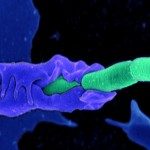Link to Pubmed [PMID] – 18802466
PLoS One. 2008 Sep 19;3(9):e3244
BACKGROUND:
Despite the dramatic decline in the incidence of invasive pneumococcal disease (IPD) observed since the introduction of conjugate vaccination, it is feared that several factors may undermine the future effectiveness of the vaccines. In particular, pathogenic pneumococci may switch their capsular types and evade vaccine-conferred immunity.
METHODOLOGY/PRINCIPAL FINDINGS:
Here, we first review the literature and summarize the available epidemiological data on capsular switch for S. pneumoniae. We estimate the weekly probability that a persistently carried strain may switch its capsule from four studies, totalling 516 children and 6 years of follow-up, at 1.5×10(-3)/week [4.6×10(-5)-4.8×10(-3)/week]. There is not enough power to assess an increase in this frequency in vaccinated individuals. Then, we use a mathematical model of pneumococcal transmission to quantify the impact of capsular switch on the incidence of IPD in a vaccinated population. In this model, we investigate a wide range of values for the frequency of vaccine-selected capsular switch. Predictions show that, with vaccine-independent switching only, IPD incidence in children should be down by 48% 5 years after the introduction of the vaccine with high coverage. Introducing vaccine-selected capsular switch at a frequency up to 0.01/week shows little effect on this decrease; yearly, at most 3 excess cases of IPD per 10(6) children might occur due to switched pneumococcal strains.
CONCLUSIONS:
Based on all available data and model predictions, the existence of capsular switch by itself should not impact significantly the efficacy of pneumococcal conjugate vaccination on IPD incidence. This optimistic result should be tempered by the fact that the selective pressure induced by the vaccine is currently increasing along with vaccine coverage worldwide; continued surveillance of pneumococcal populations remains of the utmost importance, in particular during clinical trials of the new conjugate vaccines.


